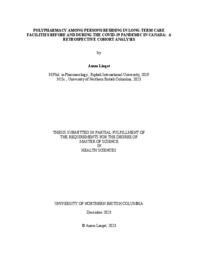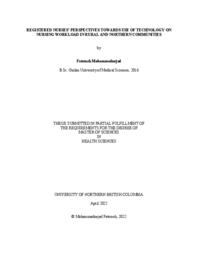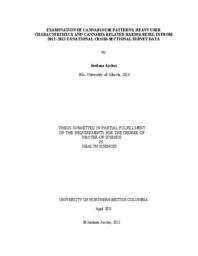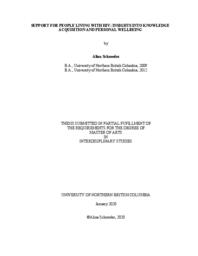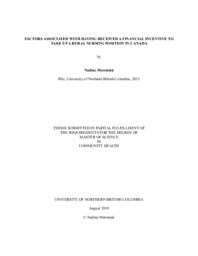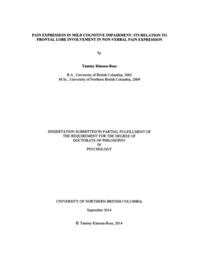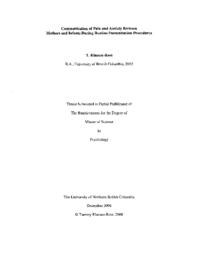Klassen-Ross, Tammy
Person Preferred Name
Tammy Klassen-Ross
Related Works
Content type
Digital Document
Origin Information
Content type
Digital Document
Origin Information
Content type
Digital Document
Origin Information
Content type
Digital Document
Description / Synopsis
Background: Technology has an important role in health delivery. One of the uses of technology in the healthcare field is to reduce Registered Nurses’ (RNs) workload. Reducing RNs’ workload can increase health delivery efficiency. Objective: To find out RNs’ perspectives towards the use of technology, including the Steadiwear glove, on their workload in rural and northern communities. Methods: A literature review was conducted, guided by a scoping review methodology and 35 articles were included. Subsequently, semi-structured interviews were conducted with eleven RNs who shared their perspectives towards technology use on their workload. Thematic analysis and an inductive approach guided by Creswell and Creswell, (2018) was undertaken. Results: Two main themes and six subthemes about the effects of technology use on RNs’ workload were found. The results revealed some technologies like the Steadiwear glove have the potential to decrease RNs’ workload by increasing the independence of persons' living with Essential Tremor (ET) and Parkinson’s Disease (PD). Further, the results demonstrated participants’ perspectives towards five technology categories including, Information and Communication technologies, E-communication, E-learning, mHealth, and Assistive devices. Elearning was the technology most commonly described by the participants and mHealth use was described the least. Factors such as decision-making based on urban setting, technology resources, and suitable training and support for using technology may affect RNs’ workload. Conclusion: Different types of technology may affect RNs’ workload depending on factors such as nurses’ acceptance, patients’ acceptance, educating users, healthcare setting (urban or rural), and technology support.
Origin Information
Content type
Digital Document
Description / Synopsis
The question explored through this research study is: Does modelling Universal Design for Learning to university faculty as learners deepen their engagement as educators? Through providing training where faculty themselves are learning about Universal Design for Learning (UDL) through a UDL modelled environment (CAST, 2018b; Meyer, Rose, & Gordon, 2014), this research project investigates if this experience translates into a stronger role as educators for these faculty. Participants in this research project are faculty members teaching in disciplines associated with Natural Resources and Environmental Studies. Through a virtual World Café, participants of the workshop shared their reflections and experiences as they learned about learning. Using the UDL framework’s horizontal organization, as conceptualized by CAST, as a lens, participant reflections were themed to determine their progression towards learning and understanding the UDL framework in this context. Evaluation of this research data indicated that faculty in this study are located along UDL Access and Build rows of the UDL Guidelines reflecting a novice learning stage where greater cognitive energy is required (Posey, 2019a, 2019b). This knowledge provides evidence that professional development opportunities should support strategies and provide the guidance necessary to foster their skills towards the UDL goal of becoming an expert learner. Elevating faculty to the UDL expert teacher level in this context enhances their skills and understanding in their creation of inclusive learning environments for their classrooms (Meyer, Rose, & Gordon, 2014).
Origin Information
Content type
Digital Document
Description / Synopsis
This thesis aimed to examine cannabis use patterns by quantity in the United States, identify key characteristics of the heaviest cannabis users, and conduct an initial assessment of whether the prevention paradox may hold for cannabis use in the United States. Using data from the National Epidemiologic Survey on Alcohol and Related Conditions – III, findings suggest that a small portion of the cannabis-using population consumes the majority of the yearly cannabis supply in the United States. Characteristics that affect the odds of being a heavy cannabis user include age, sex, personal income, education level, age of initiation, and the presence of a cannabis use or nicotine use disorder. A larger absolute number of cases experience cannabis-related harms in the low-to-moderate-using group compared to the heaviest-using group. However, a higher percentage of heavy cannabis users experience cannabis-related harms. Therefore, a dual-pronged approach of both targeted and population-based strategies may be appropriate.
Origin Information
Content type
Digital Document
Description / Synopsis
Methods for cumulative threat mapping, such as the human footprint, have been rapidly developing to inform the management of biodiversity and ecosystem services. Here, I perform the first comprehensive literature review establishing what methods are used, what threats are mapped and where, and if threats or impacts are mapped statically or dynamically in time. From knowledge gained in the review, I compiled geospatial datasets in a geographic information system to map the first Canadian human footprint. Subsequently, I answer where the most intact and heavily threatened areas are, what the most prevalent threats in Canada are and assess the accuracy of the data through a technical validation. This thesis contributes to conservation science by highlighting where regional studies are lacking, which threats are not being captured, providing examples of how studies have managed dynamic timescales and mapped through to impacts, and provides key information for future conservation in Canada.
Origin Information
Content type
Digital Document
Description / Synopsis
The provision of care for people living with Human Immunodeficiency Virus (HIV) has advanced since the 1980’s. New treatments have changed HIV to a chronic condition instead of a death sentence. How this change has affected support networks providing care to those living with HIV requires further investigation. Through interviews with Key Informants (n=4), and Family and Peer Support Networks for those living with HIV (n=7) three major themes emerged: 1) People providing support for people living with HIV are often HIV positive themselves. 2) Methods of learning about HIV/AIDS utilized before and after HIV diagnosis; such as, doctors, pamphlets, and others living with HIV. 3) Methods of support provided and received while living with HIV. These themes demonstrate the collaboration between support networks for people living with HIV. This research provides a greater understanding of support networks affected by and living with HIV.
Origin Information
Content type
Digital Document
Description / Synopsis
In Canada, financial incentives are used to entice nurses to rural practice. While financial incentives are used throughout Canada, the characteristics of nurses who have received a financial incentive are seldom examined. The purpose of the study is to examine what factors are associated with having received a financial incentive to practice in rural and remote Canada. A pan-Canadian survey was distributed to nurses working in rural and remote Canada. The survey received a 40% response rate (n=3,822). Of the 3,822 eligible nurses who responded 12.6%(n=466) of nurses identified as having received a financial incentive to take up their rural nursing position. Chi-square and multiple logistic regression analyses found characteristics and other factors associated with having received a financial incentive to take up a rural nursing position. The study concludes that financial incentives continue to have implications for recruitment of nurses to practice in rural Canada.
Origin Information
Content type
Digital Document
Origin Information
Content type
Digital Document
Origin Information
Content type
Digital Document
Origin Information



